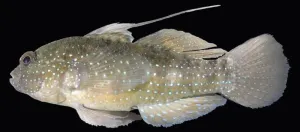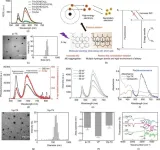(Press-News.org) The 2024 Summer Olympics are in full swing. One of the marquee events is of course the marathon, a grueling test of fitness and athleticism.
When it comes to endurance running, humans are among the very top mammals in their athletic prowess. While we may not be the best sprinters in the animal kingdom, we can run steadily for long distances, even in hot weather. Our locomotor muscles are dominated by slow-twitch, fatigue-resistant fibers and our unique ability to sweat allows our bodies to effectively dissipate heat.
Humans are so good at endurance running, it seems we were born to do it. But why?
A theory of endurance
In 1984, biologist David Carrier proposed the endurance pursuit hypothesis to explain why humans are such good long-distance runners. According to the theory, endurance running traits in humans evolved to allow us to run down large game animals through persistence hunting.
Twenty years later, Carrier’s theory was expanded upon by scientists Dennis Bramble and Daniel Lieberman, who highlighted the physiological traits conducive to endurance running. They proposed that such traits first appeared in the Homo genus nearly 2 million years ago and “may have been instrumental in the evolution of the human body form.”
The endurance pursuit hypothesis, however, isn’t without its skeptics.
“There are two reservations that have always clung to this hypothesis,” said Bruce Winterhalder, professor emeritus in the UC Davis Department of Anthropology and Graduate Group in Ecology. “One is that running is more costly than walking, so based on a simple cost-benefit analysis, it doesn’t look like an efficient way of hunting.”
“And then secondly, we have some examples of contemporary hunter-gatherers practicing endurance pursuits but probably less than a dozen cases,” he said. “For the skeptics, endurance pursuits can’t have been that important to hunting evolution in the Paleolithic if it’s not that important to hunter-gatherers now.”
But in a recent study appearing in Nature Human Behaviour, Winterhalder and paleoanthropologist Eugène Morin, of Trent University, combine mathematical modeling and a multi-year, ethnohistoric investigation of first-hand accounts of endurance pursuits to bolster support for Carrier’s hypothesis.
Sifting through history
According to Winterhalder, the recent availability of thousands of digitized accounts written by explorers, missionaries and officials combined with analytical software capable of sifting through them was key to uncovering examples of endurance pursuits throughout history.
“We have software that allows us to search for information that dwarfs what we could do if we were trying to read through all the possible sources ourselves,” Winterhalder said.
Thanks to this technology, Winterhalder and Morin uncovered 391 descriptions of hunts, dating from 1527 through the early 20th century, that matched endurance pursuit tactics. Accounts originated from 272 locations around the world, which suggests that endurance pursuit hunting was widely practiced and occurred in diverse environments.
Analyzing the data
Across the historical data, endurance pursuits followed a similar trajectory: hunters encounter a prey animal; a pursuit occurs (with the prey animal rapidly outdistancing the hunters); the prey animal pauses to recuperate after exhausting themselves (allowing the slower-paced hunters to catch up); the prey animal flees again; and the cycle repeats until the animal is completely exhausted and overtaken.
Within that common pattern, tactics differed.
“There are a fair number of cases in which these pursuits are done by teams, by relay. We also have cases where there’s an individual who will climb a hill nearby and use hand signals to indicate where the animal is going, so the person following can take shortcuts and save energy,” Winterhalder said.
This cooperation during endurance pursuit hunting hints at a social element related to running in humans. According to Winterhalder, exhibiting such athletic prowess could have been a way for males to showcase their value among the community, elevating their social status or chances of finding mates.
In a follow-up study, Winterhalder and Morin plan to further examine female participation in endurance running. While instances of female participation only occurred in about 3-4% of the accounts in the study’s dataset, Winterhalder said that doesn’t necessarily mean females were not good runners.
“In a fair number of cases, we did find that there are festivals, feasts and ritual events that involve running contests,” Winterhalder said. “In cases where we find mentions of rituals or games, the participants generally are women, men and children.”
It also doesn’t mean that women weren’t involved in hunts as recent research shows "evidence that early women were also hunting."
Backing it up with math
Since his graduate student days at Cornell University, Winterhalder has specialized in adapting mathematical models devised by biologists for calculating the value of pursuing game versus the time and energy costs.
For this latest study, Winterhalder and Morin used the models to account for increasing velocity during game pursuits. He and Morin then compared return rates from endurance pursuit hunts to other common foraging methods.
“We found that in contexts like high heat or a substrate that impedes the animal, such as crusted snow, the net return rate of food acquisition from endurance pursuits can match or exceed that of other methods of prey acquisition. The chance of pursuit failure appears to diminish, and exhausted prey are safer to approach. For early humans without ballistic weaponry, these are significant advantages," Winterhalder said.
Winterhalder hopes the research will generate more interest in the scientific community about the origins of our running gait and, possibly, why some people find the activity to be incredibly satisfying, à la the proverbial “runner’s high.”
“To run long distances, to have an evolved gait that’s uniquely imbued with stamina is unusual in the animal world,” Winterhalder said. “If that inspires you to go for a run, great.”
END
Humans are born to run
Hunting by endurance pursuit is widespread among humans, new work shows
2024-07-31
ELSE PRESS RELEASES FROM THIS DATE:
Medicaid enrollees struggle to find psychiatric care
2024-07-31
Many people enrolled in Medicaid who require psychiatric care have difficulty accessing clinicians in a timely manner despite the higher need in this population, according to a study by researchers at Weill Cornell Medicine.
The results published July 31 in JAMA found that few psychiatrists and other mental health professionals who are listed as accepting new patients enrolled in Medicaid are actually reachable and have appointments available. In cases when appointments could be made, wait times sometimes extended up to six months. The research was conducted by first author Dr. Diksha Brahmbhatt (M.D. ’24), who is now a resident physician at Brigham and Women’s ...
Smithsonian scientists devise method to secure Earth’s biodiversity on the moon
2024-07-31
New research led by scientists at the Smithsonian proposes a plan to safeguard Earth’s imperiled biodiversity by cryogenically preserving biological material on the moon. The moon’s permanently shadowed craters are cold enough for cryogenic preservation without the need for electricity or liquid nitrogen, according to the researchers.
The paper, published today in BioScience and written in collaboration with researchers from the Smithsonian’s National Zoo and Conservation ...
Revolutionary x-ray-sensitizers could transform cancer treatment with low-dose radiation therapy
2024-07-31
Researchers at Xiamen University have made a significant advancement in cancer treatment by developing a novel class of X-ray-sensitizers (XSs) that could revolutionize radiotherapy. Published in Engineering, their groundbreaking study highlights how specific organic pharmaceutical drug intermediates, derived from thioxanthone (TX), can be activated by low-dose X-rays to efficiently generate singlet oxygen for targeted cancer therapy.
Traditional radiotherapy, a cornerstone in cancer treatment, often involves high doses of radiation (typically over 50 Gy), which can lead ...
ATMs and other digital self-serve devices fail to meet accessibility needs
2024-07-31
Most self-service interactive devices — kiosks, ATMs and other digital interfaces — don't measure up to the accessibility needs of Canadians who report to have a disability, a new study has found.
In partnership with the CSA Group (Canadian Standards Association), University of Waterloo researchers interviewed people with lived experiences of disability and received an overwhelming consensus that most self-serve devices have little to no accessibility features or they have trouble finding ...
520-million-year-old worm fossil solves mystery of how modern insects, spiders and crabs evolved
2024-07-31
A new study led by researchers at Durham University have uncovered an incredibly rare and detailed fossil, named Youti yuanshi, that gives a peek inside one of the earliest ancestors of modern insects, spiders, crabs and centipedes.
This fossil dates back over 520 million years to the Cambrian period, when the major animal groups we know today were first evolving.
This fossil belongs to a group called the euarthropods, which includes modern insects, spiders and crabs. What makes this fossil so special ...
A new use for propofol in treating epilepsy?
2024-07-31
The general anesthetic propofol may hold the keys to developing new treatment strategies for epilepsy and other neurological disorders, according to a study led by researchers at Weill Cornell Medicine and Sweden’s Linköping University.
In their study, published July 31 in Nature, the researchers determined the high-resolution structural details of how propofol inhibits the activity of HCN1, an ion channel protein found on many types of neurons. Drug developers consider inhibiting HCN1 a promising strategy for treating neurologic disorders including epilepsy and chronic pain. The researchers also found, to their surprise, that when HCN1 contains ...
Trust in physicians and hospitals during the COVID-19 pandemic in a 50-state survey of US adults
2024-07-31
About The Study: The results of this survey study of U.S. adults suggest that trust in physicians and hospitals decreased during the COVID-19 pandemic. As lower levels of trust were associated with lesser likelihood of pursuing vaccination, restoring trust may represent a public health imperative.
Corresponding Author: To contact the corresponding author, Roy H. Perlis, MD, MSc, email rperlis@mgh.harvard.edu.
To access the embargoed study: Visit our For The Media website at this link https://media.jamanetwork.com/
(doi:10.1001/jamanetworkopen.2024.24984)
Editor’s ...
State policies regulating firearms and changes in firearm mortality
2024-07-31
About The Study: In this comparative effectiveness study of state firearm policies, the joint effect estimates of combinations of firearm laws were calculated, showing that restrictive firearm policies were associated with substantial reductions in firearm mortality. Although policymakers would benefit from knowing the effects of individual policies, the estimated changes in firearm mortality following implementation of individual policies were often small and uncertain.
Corresponding Author: To contact the corresponding ...
City-level sugar-sweetened beverage taxes and youth body mass index percentile
2024-07-31
About The Study: Sugar-sweetened beverage excise taxes were associated with lower body mass index percentile among youth in this cohort study. Policymakers should consider implementing sugar-sweetened beverage excise taxes to prevent or reduce youth overweight and obesity and, ultimately, chronic disease, particularly among children younger than 12 years.
Corresponding Author: To contact the corresponding author, Deborah Rohm Young, PhD, email deborah.r.young@kp.org.
To access the embargoed study: Visit our For The Media website at this link https://media.jamanetwork.com/
(doi:10.1001/jamanetworkopen.2024.24822)
Editor’s ...
Impact of neighborhood resources on resilience after trauma
2024-07-31
E. Kate Webb, PhD, a research fellow at McLean Hospital who works in the Neurobiology of Fear Laboratory and Neurobiology of Affective and Traumatic Experiences Laboratory, led an investigation into whether individual resources and neighborhood resources, like greenspace, might impact neurobiology and the trajectory of posttraumatic stress disorder (PTSD) symptoms. Her research was published July 31st in JAMA Psychiatry.
What led you to examine the link between neighborhood characteristics and PTSD?
About 46 million people experience ...
LAST 30 PRESS RELEASES:
Beyond small data limitations: Transfer learning-enabled framework for predicting mechanical properties of aluminum matrix composites
Unveiling non-thermal catalytic origin of direct current-promoted catalysis for energy-efficient transformation of greenhouse gases to valuable chemicals
Chronic breathlessness emerging as a hidden strain on hospitals
Paleontologists find first fossil bee nests made inside fossil bones
These fossils were the perfect home for ancient baby bees
Not everyone reads the room the same. A new study examines why.
New research identifies linked energy, immune and vascular changes in ME/CFS
Concurrent frailty + depression likely boost dementia risk in older people
Living in substandard housing linked to kids’ missed schooling and poor grades
Little awareness of medical + psychological complexities of steroid cream withdrawal
Eight in 10 trusts caring for emergency department patients in corridors, finds BMJ investigation
NASA’s Webb telescope finds bizarre atmosphere on a lemon-shaped exoplanet
The gut bacteria that put the brakes on weight gain in mice
Exploring how patients feel about AI transcription
Category ‘6’ tropical cyclone hot spots are growing
Video: Drivers struggle to multitask when using dashboard touch screens, study finds
SLU research shows surge in alcohol-related liver disease driving ‘deaths of despair’
Rising heat reshapes how microbes break down microplastics, new review finds
Roots reveal a hidden carbon pathway in maize plants
Membrane magic: FAMU-FSU researchers repurpose fuel cells membranes for new applications
UN Member States pledge to increase access to diagnosis and inhaled medicines for the 480 million people living with COPD
Combination therapy shows potential to treat pediatric brain cancer ATRT
Study links seabird nesting to shark turf wars in Hawai‘i
Legal sports betting linked to sharp increases in violent crime, study finds
Breakthrough AI from NYUAD speeds up discovery of life-supporting microbes
New Eva Mayr-Stihl Foundation funding initiative boosts research at University of Freiburg on adaptation of forests to global change
The perfect plastic? Plant-based, fully saltwater degradable, zero microplastics
Bias in data may be blocking AI’s potential to combat antibiotic resistance
Article-level metrics would provide more recognition to most researchers than journal-level metrics
Satiety’s little helper: Protein that supports appetite regulating protein identified
[Press-News.org] Humans are born to runHunting by endurance pursuit is widespread among humans, new work shows



